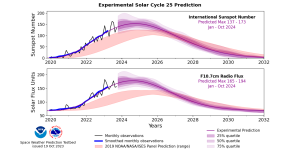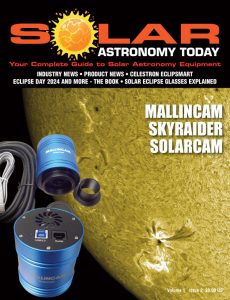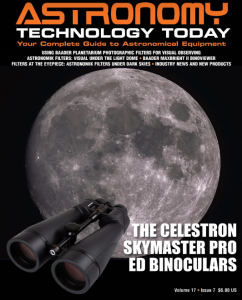The upcoming 2024 total solar eclipse is to be better than anticipated according to the National Oceanic and Atmospheric Administration (NOAA). The organization has announced that the NOAA’s Space Weather Prediction Center (SWPC) has issued a revised prediction for solar activity during Solar Cycle 25 that concludes solar activity will increase more quickly and peak at a higher level than that predicted. The updated prediction now calls for Solar Cycle 25 to peak between January and October of 2024.
 This is especially good news for those planning for the Total Solar Eclipse on April 8, 2024 as the Sun may offer a particularly impressive corona which is the extended outer atmosphere of the Sun that is only visible during an eclipse. For those who will be doing solar imaging of the eclipse, this means that the images available may be more spectacular than were available during the 2017 solar eclipse.
This is especially good news for those planning for the Total Solar Eclipse on April 8, 2024 as the Sun may offer a particularly impressive corona which is the extended outer atmosphere of the Sun that is only visible during an eclipse. For those who will be doing solar imaging of the eclipse, this means that the images available may be more spectacular than were available during the 2017 solar eclipse.
This prediction of significantly increased solar activity marks the debut of SWPC’s experimental Updated Solar Cycle Prediction Product on the Space Weather Prediction Testbed website.
Mark Miesch, a CIRES scientist who serves as the solar cycle lead at SWPC, said the forecast for Cycle 25 had not been updated since its release in 2019 and is no longer representative of the potential solar activity.
“We expect that our new experimental forecast will be much more accurate than the 2019 panel prediction and, unlike previous solar cycle predictions, it will be continuously updated on a monthly basis as new sunspot observations become available,” Miesch said. “It’s a pretty significant change.”
No two solar cycles are the same, Miesch added. Solar magnetic variability, which the SWPC measures by sunspot activity, regulates the frequency and severity of space weather events and hazards, which can interfere with the electrical grid, degrade GPS signals, increase orbital drag on satellites, and pose radiation hazards to airline crews and astronauts. Stronger solar cycles produce more solar storms with greater intensity and therefore pose a larger hazard for these critical technologies and services.
The 2019 panel, convened by NOAA, NASA, and the International Space Environment Services (ISES), predicted that Solar Cycle 25, following a relatively weak Solar Cycle 24, would also be weak, peaking in July 2025 at a maximum sunspot number of 115. Solar Cycle 24 was the weakest cycle in 100 years with sunspot number peaking at 116 for the solar cycle, well below average, which is 179. NOAA’s new prediction, though larger than the panel prediction and larger than Cycle 24, would still make the strength of Solar Cycle 25 below average.
SWPC is a division of the National Weather Service and is the nation’s civilian authority for space weather alerts, watches, warnings, and advisories. Visit www.spaceweather.gov for updates.

 The Sun is more active than it’s been in years and if that’s not enough, we have the Annular Solar Eclipse on October 14, 2023 and the Total Solar Eclipse on April 8, 2024! If you’d like to learn more about the technology behind solar observing, solar imaging and more, you can check out our new monthly magazine – Solar Astronomy Today. It’s free to read, no subscription needed and available here. And if you are preparing for the upcoming eclipses and want to know your equipment options from solar glasses to the most out of this world solar viewing and imaging options, check out our free publication – The Definitive Guide to Viewing and Imaging the Sun – simply click here and enjoy reading!
The Sun is more active than it’s been in years and if that’s not enough, we have the Annular Solar Eclipse on October 14, 2023 and the Total Solar Eclipse on April 8, 2024! If you’d like to learn more about the technology behind solar observing, solar imaging and more, you can check out our new monthly magazine – Solar Astronomy Today. It’s free to read, no subscription needed and available here. And if you are preparing for the upcoming eclipses and want to know your equipment options from solar glasses to the most out of this world solar viewing and imaging options, check out our free publication – The Definitive Guide to Viewing and Imaging the Sun – simply click here and enjoy reading!
And to make it easier for you to get the most extensive news, articles and reviews that are only available in the magazine pages of Astronomy Technology Today, we are offering a 1-year magazine subscription for only $6! Or, for an even better deal, we are offering 2 years for only $9. Click here to get these deals which only will be available for a very limited time. You can also check out a free sample issue here.



